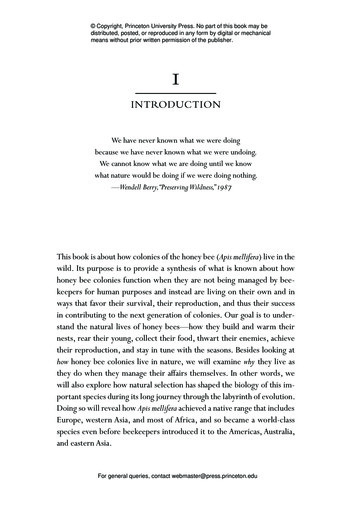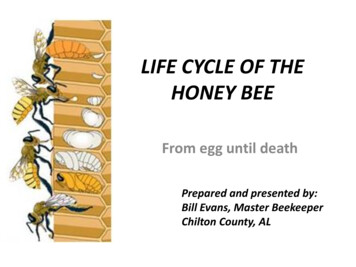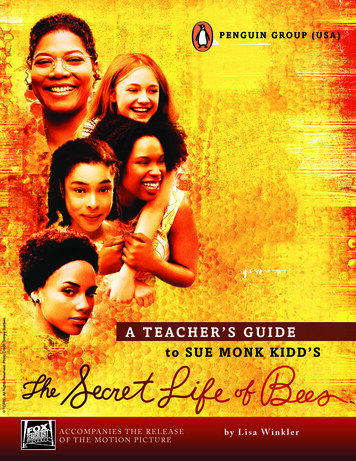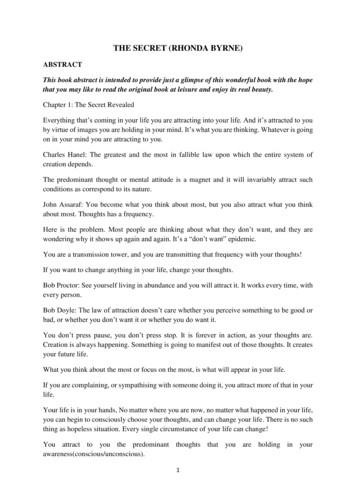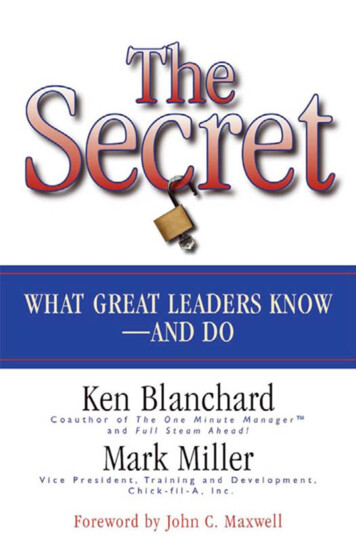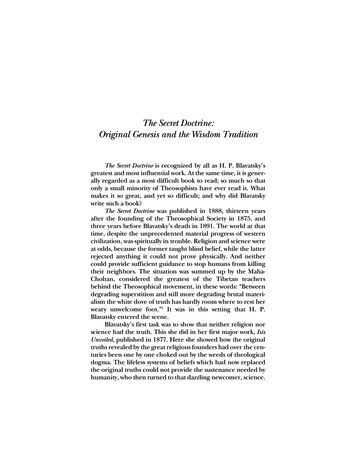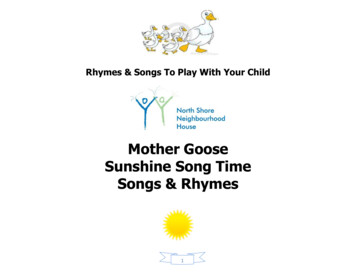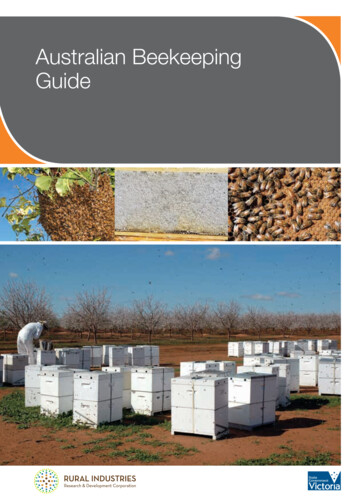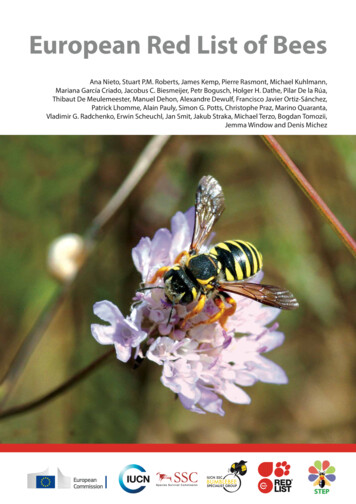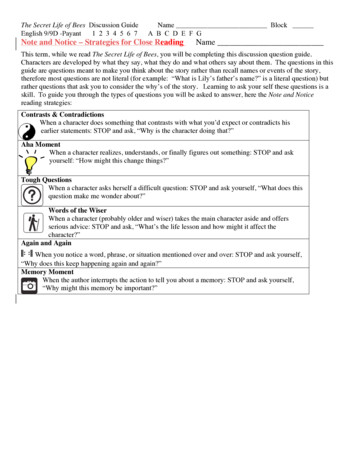
Transcription
The Secret Life of Bees Discussion GuideEnglish 9/9D -Payant1 2 3 4 5 6 7Name BlockA B C D E F GNote and Notice – Strategies for Close ReadingNameThis term, while we read The Secret Life of Bees, you will be completing this discussion question guide.Characters are developed by what they say, what they do and what others say about them. The questions in thisguide are questions meant to make you think about the story rather than recall names or events of the story,therefore most questions are not literal (for example: “What is Lily’s father’s name?” is a literal question) butrather questions that ask you to consider the why’s of the story. Learning to ask your self these questions is askill. To guide you through the types of questions you will be asked to answer, here the Note and Noticereading strategies:Contrasts & ContradictionsWhen a character does something that contrasts with what you’d expect or contradicts hisearlier statements: STOP and ask, “Why is the character doing that?”Aha MomentWhen a character realizes, understands, or finally figures out something: STOP and askyourself: “How might this change things?”Tough QuestionsWhen a character asks herself a difficult question: STOP and ask yourself, “What does thisquestion make me wonder about?”Words of the WiserWhen a character (probably older and wiser) takes the main character aside and offersserious advice: STOP and ask, “What’s the life lesson and how might it affect thecharacter?”Again and Again When you notice a word, phrase, or situation mentioned over and over: STOP and ask yourself,“Why does this keep happening again and again?”Memory MomentWhen the author interrupts the action to tell you about a memory: STOP and ask yourself,“Why might this memory be important?”
The Secret Life of Bees Discussion GuideEnglish 9/9D -Payant1 2 3 4 5 6 7Name BlockA B C D E F GThe Four Rules of Shared Inquiry Discussion1. Only those who have read the selection may take part in the discussion. Participants who have not read theselection cannot support their opinions with evidence from the text, nor can they bring a knowledge of the textto bear on the opinions of others. Therefore, the focus can be interpretations of text and capitalizing on the closereading of it.2. Discussion is restricted to the selection that everyone has read. This rule gives everyone an equal chance tocontribute, because it limits discussion to a selection that all participants are familiar with and have before them.When the selection is the sole focus of discussion, everyone can determine whether facts are accurately recalledand opinions adequately supported.3. Support for opinions should be found within the selection. Participants may introduce outside opinions only ifthey can restate the opinions in their own words and support the ideas with evidence from the selection. Thisrule encourages participants to read carefully and think for themselves.4. Leaders may only ask questions—they may not answer them. Leaders help themselves and participantsunderstand a selection by asking questions that prompt thoughtful inquiry; personal validation comes throughdiscussants responding by carefully considering a well-supported perspective.Your discussions will be richer and more productive if you remember to: Temper the urge to speak with the discipline to listen Substitute the impulse to teach with a passion to learn Hear what is said and listen for what is meant Marry your certainties with others' possibilities Reserve judgment until you can claim understandingFrom: http://www.greatbooks.com/index.php?id sidrulesShort version:Rules for Shared Inquiry Discussions1. Discussion is restricted to the text everyone has read.2. Only those who have read the text may participate.3. Interpretations must be supported by evidence from the text.4. Leader may ask, not answer, questions.If you have not read the text and completed your guide prior to discussion, you will miss out on discussion andtherefore miss out on a learning opportunity.Holistic RubricCategoryA – Answer theprompts.1-No evidenceDid not answermost questions.P – Provideexample(s) fromthe textE – Explain howthe example(s)supports theanswer.Did not provideexamples fromthe text.Did not provideexplanations.2 -Emerging/GainingAnswered the questionswithout using keywords from the prompt.Provided insufficientexamples from the text.3- ProficientAnswered the promptusing key words fromthe prompt.Provided examplesfrom the text.Did not explain howeach example and /orquotation supported theanswer.Explained how eachexample and /orquotation helped tosupport the answer.4 -ExemplaryAnswered the promptusing key words fromthe prompt.Provided excellentexamples from thetext.Explained clearly howeach example and / orquotation helped tosupport the answer.
The Secret Life of Bees Discussion GuideName BlockEnglish 9/9D -Payant1 2 3 4 5 6 7 A B C D E F GDuring The Secret Life of Bees, sometimes you will be engaged in small group discussion. In order to have afocused discussion where each member contributes you will be assigned one of the following roles. The virtuesof the system below are that the roles don't divert participants from participating in the activity and everyone,not only a reporter, gets to reflect and synthesize what happened.Roles: Assume roles according to the number you have been assigned for discussion. On other days we mayassign roles alphabetically (first or last name) or as we go on, you may be allowed to chose and negotiate yourrole in the group.1.2.3.4.Facilitator of ParticipationOrienter for the ActivityTimerReporterPhases of Small Group Activity:I.Getting Together to Begin ActivityII. Activity5. Encourager6. Observer7. Information-seekerIII. Synthesis and ReflectionIV. ReportPhase I. Getting Together to Begin Activity1. Facilitator of Participationo Choose a space and set up chairs so everyone can face each other and hear comfortably.o Bring everyone into the group, not off to one side or facing the group on an angle.o Make sure everyone in the group is introduced to others they don't know.2. Orienter for the Activityo Give your version of the activity and goals, invite others to revise this, and check that everyoneknows what's going on and why. If it's not clear after that, call for instructor's attention.o [Teacher inserts here a description of the Activity, specifying time allocated for each phase.]Phase II. Activity1. Facilitator (cont.)o Insure everyone gets a chance to speak.o Bring people back into the group when they have withdrawn (on their own or in a 1on1discussion).o Ask for time out for a check-in when withdrawal recurs/persists.o Take notes to aid synthesis and reflection by yourself and for the group.2. Orienter (cont.)o Call for instructor's attention when group needs more guidance about where they are going.o Take notes to aid synthesis and reflection by yourself and for the group.3. Timero Watch time, prompting group to move onto next task or prompting facilitator to make space forpeople who haven't had time to speak.o Insure that clear time is left at the end for synthesis and reflection.o Take notes to aid synthesis and reflection by yourself and for the group.4. Reportero Take notes to aid synthesis and reflection by yourself and for the group.5. Encourager: Provides positive feedback“I think what Heather was saying was totally right.”6. Observer: Evaluates group progress“I think we’ve learned a lot so far. Sara and Heather gave us great information.”7. Information-seeker: Asks for clarification“Lisa D. or Laura, could you please tell me what you said about disconfirming responses?”
The Secret Life of Bees Discussion GuideEnglish 9/9D -PayantPhase III. Synthesis and ReflectionName Block1. Facilitatoro Check in quietly with anyone who has stalled in their synthesis and note-making.o Digest the content and process of the discussion and make notes on your own conclusionsand open questions.2. Orientero Digest the content and process of the discussion and make notes on your own conclusionsand open questions.3. Timero Digest the content and process of the discussion and make notes on your own conclusionsand open questions.4. Reportero Ask everyone to mention one highlight, appreciation, or issue needing further work from thecontent or the process of the discussion. Make notes.o Prepare to report back, either spoken to the class as a whole or given to instructor.5. EncouragerDigest the content and process of the discussion and make notes on your own conclusions and openquestions.6. ObserverDigest the content and process of the discussion and make notes on your own conclusions and openquestions.7. Information-seekerDigest the content and process of the discussion and make notes on your own conclusions and openquestions.Phase IV. ReportReporter gives report, either spoken to the class as a whole or in written form for the instructorto disseminate.
The Secret Life of Bees Discussion GuideEnglish 9/9D -PayantName BlockThe Secret Life of Bees mini-research note pageUse this page to jot down a note or two, an impression if you would like, of the various topics presented byclassmates as referenced in The Secret Life of Bees.Chapter 1 References Sophia Loren, 9 Khrushchev, LBJ, 1964, Civil Rights Act, 20 Martin Luther King,Jr., 21.Chapter 2 Reference The Supremes’ Where Did Our Love Go?, 50 Chapter 3 ReferencesShakespeare, Henry David Thoreau, Eleanor Roosevelt, 57 Dixie, Confederate Flag, Fort Sumter, hulahoops, Goldwater for President signs, Vietnam, Castro, Malcolm X, Saigon, 65 The Beatles, 66 Chapter 4Reference Church bombing in Birmingham, 4 girls killed, 80 Chapter 5 References Walter Cronkite, 88Chapter 6 References None Chapter 7 Jane Eyre, Fats Domino, Miles Davis, 117. Play samples and/orshow film clips of their music to help students understand the discussion between Lily and Zach. TheFugitive, 123 Chapter 8 Reference Jack Palance, 154 Chapter 9 References Niagara Falls, people goingover in barrels, 165 Civil Rights Act, 166 American Bandstand, Dick Clark, 175 Ed Sullivan, 185 Chapter10 Reference Aristaeus, Greek myth, 206 Chapter 11 References Florida Everglades, 219 Chapter 12References Robert Frost 237 13, none –Chapter 14 References Goldwater/Humphrey election, 283 NatKing Cole, 285TopicSophia LorenKhrushchevLBJ1964 Civil Rights ActMartin Luther King, Jr.The Supremes’ Where Did Our Love Go?ShakespeareHenry David ThoreauEleanor RooseveltDixieConfederate FlagFort Sumterhula hoopsGoldwater for President signsVietnamCastro
The Secret Life of Bees Discussion GuideEnglish 9/9D -PayantMalcolm XName BlockSaigonThe BeatlesChurch bombing in Birmingham, 4 girls killedWalter CronkiteJane EyreFats DominoMiles DavisThe FugitiveJack PalanceNiagara Falls, people going over in barrelsAmerican BandstandDick ClarkEd SullivanAristaeus, Greek mythFlorida EvergladesRobert FrostGoldwater/Humphrey electionNat King ColeChapter 1 References Sophia Loren, 9 Khrushchev, LBJ, 1964, Civil Rights Act, 20 Martin Luther King,Jr., 21 Chapter 2 Reference The Supremes’ Where Did Our Love Go?, 50 Chapter 3 ReferencesShakespeare, Henry David Thoreau, Eleanor Roosevelt, 57 Dixie, Confederate Flag, Fort Sumter, hulahoops, Goldwater for President signs, Vietnam, Castro, Malcolm X, Saigon, 65 The Beatles, 66 Chapter 4Reference Church bombing in Birmingham, 4 girls killed, 80 Chapter 5 References Walter Cronkite, 88Chapter 6 References None Chapter 7 Jane Eyre, Fats Domino, Miles Davis, 117. Play samples and/orshow film clips of their music to help students understand the discussion between Lily and Zach. TheFugitive, 123 Chapter 8 Reference Jack Palance, 154 Chapter 9 References Niagara Falls, people goingover in barrels, 165 Civil Rights Act, 166 American Bandstand, Dick Clark, 175 Ed Sullivan, 185 Chapter10 Reference Aristaeus, Greek myth, 206 Chapter 11 References Florida Everglades, 219 Chapter 12, 13– none Chapter 14 References Goldwater/Humphrey election, 283 Nat King Cole, 285
The Secret Life of Bees Discussion GuideEnglish 9/9D -PayantName BlockChapter 11. “The queen, for her part, is the unifying force of the community; if she is removed from the hive, theworkers very quickly sense her absence. After a few hours, or even less, they show unmistakable signs ofqueenlessness.” How does Lily’s home show signs of queenlessness?Discuss how this magnifies issues that are considered normal for girls of Lily’s age and what additionalissues this creates.2. What can we determine about the “rules” for black and white people, during this time period, from thischapter? Provide an instance from the text that supports your opinion.3. "Jim Crow was not a person, yet affected the lives of millions of people. Named after a popular 19th-century minstrel song thatstereotyped African Americans, "Jim Crow" came to personify the system of government-sanctioned racial oppression andsegregation in the United States." "Racial inequality was not unique to the South. It was the norm across the nation, and otherregions of the United States saw similar violence and state-sanctioned discrimination. Though Jim Crow and its specific laws andpractices occurred in the South, the system thrived because it was sanctioned by the national government. The actions -- or, morefrequently, inactions -- of the three branches of the federal government were essential in defining the lifespan of Jim Crow."(separate but not equal)Consider what you know about how Jim Crow Laws affected the life of African American people in the1960s South. Discuss possible reasons why Rosaleen stood up to the white men on that particular day,instead of some other day, despite the consequences. Do you think that she was a compliant person beforethat day? Do you think that her feelings suddenly changed? You may choose to visit this website forbackground information. http://www.pbs.org/wnet/jimcrow/4. Can you give any examples from life today where Jim Crow type laws, written or unwritten, mightinfluence the relationships between people. Go beyond race (religion, socio-economics, gender) whenthinking about this question.a.b.c.5. An allusion is an indirect or passing reference to a piece of literature (such as the Bible orShakespeare) designed to call something to mind without mentioning it explicitly; In Luke 5, 26-38 theangel Gabriel brought the unmarried teenage Virgin Mary the news that she would bear God’s child.Compare Lily’s ideas about the bees to the angel. Identify how the bees and the angel serve as literarydevices (metaphor: comparison of two ideas – simile: comparison using like or as).
The Secret Life of Bees Discussion GuideName BlockEnglish 9/9D -Payant6. Compare Rosaleen’s reaction to the bees to Lily’s beliefs. What does Rosaleen say or do that lets youknow what she thinks?Answer- quotation from book (2)This quotation means:7. Memory Moment – pages 5-8Sue Monk Kidd has interrupted the action to tell you about Lily’s only memory of her mother, STOP andask yourself, “Why might this memory be important?”8. Personification is the attribution of a personal nature or human characteristics to something nonhuman, or therepresentation of an abstract quality in human form. The idiom (expression) to holler uncle or to cry uncle means toadmit defeat.When Rosaleen stands up to T. Ray about the chick, Lily says, “his boots whispered uncle all the way downthe hall.” (12) What does she mean?9. What does Lily long for? Pages 15, 16 & 26What obstacles prevent Lily from getting what she desires? Provide at least two conflicts.a.b.10. Figurative language appeals to the senses. Similes and metaphors are examples of types of figurative language.What words and figurative images indicate the strength of Lily’s feelings? Provide at least one examplefrom the text with page number.11. A simile is a comparison using like or as whereas a metaphor is a word or phrase for one thing that isused to refer to another thing in order to show or suggest that they are similar - a direct comparison (one thatdoes not use like or as). Identify a simile or a metaphor from the chapter, write it down with the page #.12. Identify the use of foreshadowing (hinting at something that will happen later) in this chapter:Discuss its purpose.Before DiscussionI’ll discuss below and then share ways in which this chapter is a window into another’s experience and or a mirrorcausing me to further examine events from my own life, emotions experiences, beliefs, opinions of my own.After DiscussionHow did discussion affect your answers? Did it change your mind? Provide additional support for an answer? Makeyou aware of additional issues?
The Secret Life of Bees Discussion GuideEnglish 9/9D -PayantName BlockChapter 21. Use evidence from the book to discuss whether or not T. Ray is a racist.Can there be degrees of racism and, if so, is it OK? Why or why not?2. What is the meaning of the metaphor of the jar: “Lily Melissa Owens, your jar is open”? (41).3. We don’t know for sure the reasons around Deborah leaving T-Ray or the cause of her death. Do youthink that Lily is ready to handle the truth, whatever it might be?How has wishful thinking helped Lily to survive?4. Aha MomentLily has had an “aha moment” – she finally realizes, understands, or has finally figured out something; at this pointSTOP and ask yourself, “How might this change things?” What events have moved Lily to action? Why doyou think that she chose now to run away, instead of last month? Think about how your own way ofviewing your world might have changed from a year ago to today when answering this question. Thisinformation on brain development of teens provides background teen brain development.Frontal CortexThe frontal cortex is often referred to as the “CEO” of the brain, because it is responsiblefor planning, strategizing, and judgment. Recent research has shown that this areaundergoes a growth spurt at around the ages of 11-12, followed by a period of pruningand organizing of the new neural connections during the teen years.“Anatomy of a Teen Brain.” Front Line. PBS - WGBH Educational Foundation. 2014. Web. 11 June /teenbrain/work/anatomy.html5. Why is Lily angry with Rosaleen? Do you think that she is justified in her feelings? (51-54)6. In what ways are Lily’s interactions with Rosaleen similar to a girl’s interactions with her mother?Before DiscussionI’ll discuss below and then share ways in which this chapter is a window into another’s experience and or a mirror causing me tofurther examine events from my own life, emotions experiences, beliefs, opinions of my own.After DiscussionHow did discussion affect your answers? Did it change your mind? Provide additional support for an answer? Make you aware ofadditional issues?
The Secret Life of Bees Discussion GuideEnglish 9/9D -Payantpage intentionally blankName Block
The Secret Life of Bees Discussion GuideEnglish 9/9D -PayantName BlockChapter 31. According to her biography on "The National First Ladies Library" website, by 1933 First Lady EleanorRoosevelt's "views had evolved to the point where equality of all races had become one of her core values asa person. Far more than her husband [FDR], she believed the U.S. government had a moral duty to initiateand enforce changes that furthered or ensured racial equality. This was viewed by the larger whitepopulation at that time as nothing short of radical, yet it never persuaded her to restrain her words anddeeds." Additionally, Mrs. Roosevelt famously said “No one can make you feel inferior without yourconsent.” and “You gain strength, courage and confidence by every experience in which you really stop tolook fear in the face. You are able to say to yourself, 'I have lived through this horror. I can take the nextthing that comes along.' You must do the thing you think you cannot do.”What qualities does the narrator evoke by personifying nature as Eleanor Roosevelt? (57) Answer andexplain.2. Compare Brother Gerald’s attitude toward Catholics to his church’s treatment of black worshippers, asdescribed in Chapter 1. Why is this attitude ironic? (58)Brother Gerald's attitude toward CatholicsHow does his church feel about black worshipers? (30)Irony is defined as “a state of affairs or an event that seems deliberately contrary to what one expects.”Christians are commanded by Christ to “love your neighbor as yourself” (Mark 12:31). Why are BrotherGerald’s attitudes ironic?Aha MomentLily has a realization based on what Brother Gerald says and how Christians are supposed to treatone another despite religion or race. What does Lily see?What does this tell you about Lily?3. Contrast Rosaleen’s dream about the Rev. Martin Luther King, Jr. (a leader of the Civil RightsMovement), to the expectations of the white church.Rosaleen's dream (59):Think about the expectations of the white church with regard to black worshipers. What do you think is thesignificance of Rosaleen’s odd dream? Consider the dream in contrast to the incident that landed Rosaleenin jail.
The Secret Life of Bees Discussion GuideName BlockEnglish 9/9D -Payant4. Lily seems to always be looking for a sign to guide her. Is this a demonstration of faith, superstition, orchildish thinking?What information would you need to make the distinction?5. Would you classify Lily finding the jars of Black Madonna Honey as a sign?6. Refer to page 60 and discuss whether Rosaleen has lost faith in the Civil Rights Act.7. What impression does Lily the narrator provide of the town of Tiburon? (59-65)What might her impression foreshadow about racial attitudes in Tiburon?8. “In a recent study [based on research by neuroscientists at Georgetown’s Medical Center], brain scans showedthat behavior in children and young adolescents naturally veers toward the egocentric.‘These results suggest that children develop introspection over time as their brains develop,’ says the study’s firstauthor, Stuart Washington, who graduated from the university in 2008 with a Ph.D. in biomedical neuroscience.‘Before then they are somewhat egocentric, which is not to mean that they are negatively self-centered, but theythink that everyone views the world in the same way they do. They lack perspective in that way.’” (“Neuroscientists’Study Shows Kids are Naturally Egocentric.” Georgetown University. Georgetown University. 29 December 2010. Web. 11 June .html )Young children are egocentric in their thinking, but this changes as children mature. Use the informationfrom the Georgetown study to discuss Lily’s thanking God for the “poor news reporting” when she does notfind any news about her and Rosaleen (65-66).Why is she glad not to read about herself? (61, 65)Before DiscussionI’ll discuss below and then share ways in which this chapter is a window into another’s experience and or a mirror causing me tofurther examine events from my own life, emotions experiences, beliefs, opinions of my own.After DiscussionHow did discussion affect your answers? Did it change your mind? Provide additional support for an answer? Make you aware ofadditional issues?
The Secret Life of Bees Discussion GuideEnglish 9/9D -PayantName BlockChapter 41. Lily is a good liar. Provide an example from a time when she lied.Lying helps Lily, but at a cost. How does lying help?At what cost?2.Again and Again Again and again Lily lies to people she meets, STOP and ask yourself, “Why does Lily keep lyingagain and again?”Because she keeps lying, what does that tell you about her?Why do you think so?3. Lily said “She fell down the front steps when we were leaving.” August and June traded looks whileRosaleen narrowed her eyes, letting me know I had done it again, speaking for her like she wasn’t eventhere” (pg72). Discuss why Lily does this to Rosaleen.4. Why doesn’t Rosaleen correct Lily’s lies?As you read on in the book, note whether Lily does this to anyone else and be prepared to discuss why orwhy not. Elderly people make the same complaint. Teens sometimes experience it as well. For what reasonsmight we tend to speak for someone who is standing right next to us instead of letting them speak forthemselves?5. Aha Moment – Again and Again Lily has a realization in the house of the calendar sisters. Why does Lily think “ my skinhad never felt so white to me”? (78, 87)6. Why does Lily think that the figurine is the Virgin Mary? (p. 70)
The Secret Life of Bees Discussion GuideName BlockEnglish 9/9D -Payant7. Start a Venn diagram, comparing Rosaleen and August. Add to it, until you have enough information towrite a compare/contrast paragraph about them.Before DiscussionI’ll discuss below and then share ways in which this chapter is a window into another’s experience and or a mirror causing me tofurther examine events from my own life, emotions experiences, beliefs, opinions of my own.After DiscussionHow did discussion affect your answers? Did it change your mind? Provide additional support for an answer? Make you aware ofadditional issues?
The Secret Life of Bees Discussion GuideEnglish 9/9D -PayantName BlockChapter 51.Memory MomentMonk Kidd interrupts the action to tell you about a memory Lily has about her mom (85), STOP and askyourself, “Why might this memory be important?” What do we learn about Lily’s mom and who inthe house does this memory relate to?What does this memory tell you about Lily’s mom’s character (her personality)?2. Why does August Boatwright agree to shelter Lily and Rosaleen? (86-87)3. Again and Again What does June say that is a “revelation” to Lily? (87)Does Lily have the right to be offended?4. For the second time in the story the TV news function is functioning as a literary device in the narrative(acting as a character in the story – providing background and context for the events that unfold). What isthe effect of watching the television news in the Boatwright house? (88)5. What does Lily mean, “Since Mr. Johnson signed that law, it was like somebody had ripped the seamsright out of American life” (88).6. Again and Again While watching the news about the racial tension in the country, Lily feels“white and self-conscious and ashamed” (89). When is a time that you have felt self conscious aboutsomething you cannot change about yourself (such as your ethnic background, gender, age, sexualorientation or faith)?7. Words of the WiserAugust takes the Lily aside and offers serious advice in the form of a story about a young nunnamed Beatrix (91). STOP and ask, “What’s the life lesson and how might it affect Lily?”
The Secret Life of Bees Discussion GuideName BlockEnglish 9/9D -Payant8. Tough QuestionsAugust’s story about May causes Lily to ask herself a difficult question. Explain the significanceof Lily’s wondering about May’s sensitivity: “Would it divide the hurt in two, make it lighter tobear, the way feeling someone’s joy seemed to double it?” (95)STOP and ask yourself, “What does this question make me wonder about?”9. The names of the “calendar sisters” have a connection more significant than the summer months. Brieflyexplain the meaning of the names May, June and August to identify this theme. - According to BabyNames.com:May- According to Babynames.com, "The month of May was named after Maia, the Greek goddess ofSpring." According to Encyclopedia Mythica in the article titled ""Maia" created on 03 March 1997; lastmodified on 01 July 2004 (Revision 2). "The Pleiades" was the name given to the seven daughters of Atlasand Pleione. Maia was the eldest of the daughters, and said to be the most beautiful. Being shy, she livedquietly and alone in a cave on Mount Cyllene, in Arcadia." In the middle ages - Matthew (Mayhew) - Mayis a pet form of Mary (mother of Christ).June- The month of June was named after the Roman goddess Juno (Iunius), goddess of Marriage &Childbirth. Hera (Roman) - protector of the family.August The meaning of the name August is "great" or "magnificent." Augusta in Ancient Rome - was thetitle taken on by the wife/mother/sister of the Emperor (Caesar Augustus).Considering the meaning of their names, what character traits distinguish May, June and August Boatwrightas evidenced in the story?MayJuneAugust10. In the quotation at the beginning of the chapter, it points out that the bees live in darkness. How is thattrue for Lily in this chapter?Before DiscussionI’ll discuss below and then share ways in which this chapter is a window into another’s experience and or a mirror causing me tofurther examine events from my own life, emotions experiences, beliefs, opinions of my own.After DiscussionHow did discussion affect your answers? Did it change your mind? Provide additional support for an answer? Make you aware ofadditional issues?
The Secret Life of Bees Discussion GuideEnglish 9/9D -PayantName BlockChapter 61. What is the number one question in South Carolina, and why is it asked? (105)What is the number one question asked of students at your school and why is it asked?2. August reads the Bible verses attributed to Mary (107, Luke 1:52 –Mary’s Song of Praise). Why are theseverses especially appropriate for African American people?3. The quotation at the beginning of the chapter (102) says the queen produces something to attract theworkers. Who might be the queen in this chapter, and what does she produce?According the Cherokee Bee Club “There can only be one queen bee per hive, if there is more than one theywill fight to the death or swarm.” In a human “hive,” might th
The Secret Life of Bees Discussion Guide Name _ Block _ English 9/9D -Payant Phase III. Synthesis and Reflection 1. Facilitator o Check in quietly with anyone who has stalled in their synthesis and note-making. o Digest the content and process of the discussion a

